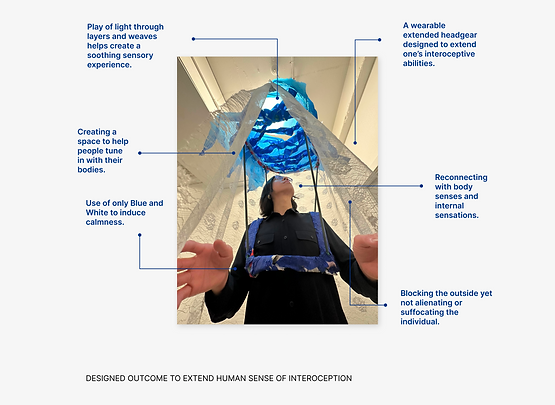Get in touch with me at ananyamanishdesigns@gmail.com

UX OF
HUMAN
SENSES
Design Brief
Conceive, make and wear a design that extends human senses beyond the body.
Designers
Binoy Thomas, Teddy Wang, Xiaolin Kuang, Ananya Manish
Allocated Sense
Interoception
Allocated Place
Tate Modern Museum, London
Research Methodologies
Body storming, Prototyping, Evaluative research
Researching Beyond The Human Sense
The first activity that we embarked upon as a group was using a device that helped us hear electromagnetic waves. It was a way of sensing the unheard and discovering the unknown. As the group walked around the streets of Elephants and Castles we heard inanimate objects make music. Slowly the ooching, whooshing and tichhing sounds were not just random melodies but started to take some logical form. It is truly strange how our brain is fundamentally wired to make associations. The big steel monument, the elevator, the redlight and the planted pots revealed a personality through sound that was strangely similar to the personality of their physical form.

This led me to question how we perceive new sensations or objects and further how this perception impacts our feelings. Research indicated that through predictive processing the brain leverages its existing knowledge of the world to deduce hypotheses about the causes of incoming sensory data. It is those hypotheses that give rise to perceptions in our minds. Thinking of the brain as a ‘Prediction machine’ was a very interesting concept for me. This concept also became one of the roots for our project.
The Hidden Sense: Interoception
Interoception translates to the mind’s ability to intercept body’s signals. This sense was alien to all four of us and we had to do some secondary research to define what this sense means and how we want to place this in our design. One very interesting article connected interoception with mental health. It claimed that a lack of interoceptive abilities in a person can eventually lead to depression, while an overstimulation of the same sense can lead to anxiety.

Visiting the Turbine Hall

During my visit to Tate Modern, experiencing the three ginormous installations by the Ghanaian Artist, El Anatsui, I felt that I was enwrapped, I was safe. After reading about the artist and his work I realised that he has manipulated and combined materials to explore the natural elemental forces like the earth, moon and waves. Due to the sheer size of these installations I was constantly looking up, however, the intricate details, depth in layers, patterns and the flow put me in a state of trance which then compelled me to look within. We decided to imbibe this feeling with our experiential wearable.
Designing an Experiential Wearable
After testing the final prototype and discussing it with fellow designers we realised that our concept definitely has a market and potential. However, our final prototype needs alterations and multiple testing rounds to be effective and practical in the real world.
We could have incorporated the repetitive sound of waves; a stronger sensory experience for mindfulness, rather than focusing just on the visual stimuli. This could have encouraged individuals to be more present in the moment and engage with their bodily sensations. It would have also created an embodied experience.
Lastly, I believe that in the process we slightly drifted away from creating an experience around interoception and created a product to increase mindfulness. Although these two concepts are interconnected they are not the same. My personal takeaway from this project was to have deep research roots before commencing ideation and to always test the prototype on real people.

Its All Blue: Outcome



Feedback and Reflection
After testing the final prototype and discussing it with fellow designers we realised that our concept definitely has a market and potential. However, our final prototype needs alterations and multiple testing rounds to be effective and practical in the real world.
We could have incorporated the repetitive sound of waves; a stronger sensory experience for mindfulness, rather than focusing just on the visual stimuli. This could have encouraged individuals to be more present in the moment and engage with their bodily sensations. It would have also created an embodied experience.
Lastly, I believe that in the process we slightly drifted away from creating an experience around interoception and created a product to increase mindfulness. Although these two concepts are interconnected they are not the same. My personal takeaway from this project was to have deep research roots before commencing ideation and to always test the prototype on real people.
References
Stokes, D., Matthen, M. and Biggs, S. (2017) Perception and its modalities. New York: Oxford University Press.
Bubic (2010) ‘Prediction, cognition and the brain’, Frontiers in Human Neuroscience [Preprint]. doi:10.3389/fnhum.2010.00025.
Hyundai Commission: El Anatsui: Behind the Red Moon (no date) El Anatsui. Available at: https://elanatsui.art/exhibitions/hyundai-commission-el-anatsui-behind-the-red-moon.
Weir, K. (no date) What is interoception, and how does it affect mental health? 5 questions for April Smith, Monitor on Psychology. Available at: https://www.apa.org/monitor/2023/04/sensations-eating-disorders-suicidal-behavior.
Gibson, J. (2019) ‘Mindfulness, interoception, and the body: A contemporary perspective’, Frontiers in Psychology, 10. doi:10.3389/fpsyg.2019.02012.